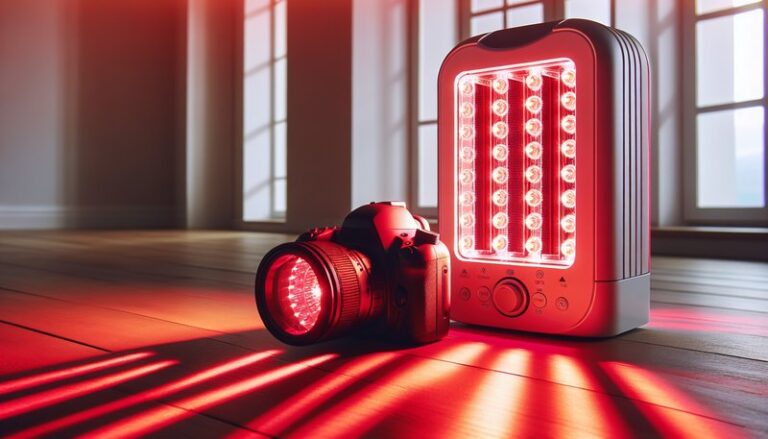How Deep Does Red Light Therapy Penetrate?
How Deep Does Red Light Therapy Penetrate?
What if there was a safe, effective way to enhance healing and rejuvenate the skin?
In recent years, red light therapy has gained popularity as a non-invasive treatment option for a variety of conditions, including pain management, skin revitalization, and promoting overall wellness. This article will explore how deep red light therapy penetrates the skin and the implications of its depth of penetration for treatment efficacy.
Key Takeaways
- Red light therapy can penetrate the skin up to several millimeters, affecting cellular functions at various levels.
- Benefits include reduced inflammation, improved wound healing, and stimulation of collagen production.
- Understanding penetration depth can inform the effectiveness of red light therapy for specific applications.
What is Red Light Therapy?
Red light therapy involves the use of specific wavelengths of light, typically in the range of 600 to 650 nanometers, which can penetrate skin tissue. This therapeutic modality is based on photobiomodulation mechanisms, where light energy stimulates cellular activity, enhancing mitochondrial function and promoting healing processes.
Red light therapy has become prevalent in both clinical settings and home-use devices. The ability of red light to penetrate the skin depends on various factors, including the type of light source, wavelength, duration of exposure, and the condition of the skin.
How Does Light Penetrate the Skin?
Understanding how deep red light penetrates involves examining its interaction with various skin layers:
- Epidermis: The outermost layer which acts as a barrier. Light penetrates here to some extent.
- Dermis: Contains connective tissues and blood vessels. This layer is where red light therapy primarily targets for therapeutic effects.
- Subcutaneous Tissue: The deepest layer, consisting of fat and connective tissue. The penetration here is minimal, but some benefits can still occur.
Research suggests that red light can penetrate through the epidermis and into the dermis, reaching depths of approximately 2 to 5 millimeters depending on the specific wavelength and intensity used.
What are the Benefits of Red Light Therapy?
Red light therapy offers a plethora of benefits that can contribute to overall health and wellness. The following points dive into the advantages provided by this innovative treatment.
Enhances Cellular Function
One of the primary benefits of red light therapy is its ability to enhance cellular function. By stimulating mitochondria, the energy producers of cells, red light therapy increases ATP production, which is crucial for cellular repair and regeneration.
Reduces Inflammation and Pain
Clinical studies have shown that red light therapy effectively reduces inflammation and pain. It can be particularly beneficial for conditions such as arthritis, joint pain, and muscle soreness, providing relief without the side effects associated with pharmaceutical interventions.
Stimulates Collagen Production
Collagen is vital for skin elasticity and firmness. Red light therapy stimulates fibroblasts in the dermis, leading to increased collagen production. This can improve the appearance of wrinkles and promote a youthful complexion.
Aids in Wound Healing
The accelerated healing properties of red light therapy can aid in the recovery of wounds and injuries. Its anti-inflammatory effects help to reduce healing time and improve tissue repair.
Is it Possible to Maximize Red Light Therapy Effects?
Maximizing the effectiveness of red light therapy is feasible with some specific actions and understanding of treatment parameters. Consider the following strategies.
What are the Advantages of Optimal Wavelength Selection?
Choosing the appropriate wavelength can enhance the treatment’s efficacy. Research suggests that wavelengths around 630-660 nanometers are particularly effective for skin treatments, whereas near-infrared light at 800-850 nanometers penetrates deeper, making it suitable for musculoskeletal issues.
What are the Advantages of Treatment Duration?
The duration of exposure to red light can significantly impact outcomes. Longer sessions (10-20 minutes) may lead to more pronounced effects, provided skin sensitivity is monitored.
What are the Advantages of Regular Treatment Sessions?
Consistency is key in achieving the desired results. Regular sessions (two to three times per week) can reinforce the therapy’s benefits, promoting sustained cellular activity and healing.
What are the Things to Consider Before Starting Red Light Therapy?
To ensure effective treatment, several factors must be taken into account before commencing red light therapy.
Skin Sensitivity
Individuals with sensitive skin may experience discomfort or adverse reactions. It’s advisable to conduct a patch test before full-body exposure to gauge individual response.
Underlying Health Conditions
Consultation with a healthcare provider is essential for those with pre-existing health issues or those taking medications that increase light sensitivity.
Device Quality
Not all red light therapy devices are created equal. Researching and selecting high-quality devices ensures optimal wavelength delivery and intensity for effective treatment.
What are the Alternatives to Red Light Therapy?
While red light therapy is acclaimed for its benefits, there are alternative therapies worth considering.
Cold Laser Therapy
Cold laser therapy utilizes low-level lasers for pain management and healing. It operates on similar principles to red light therapy but may penetrate different tissue depths.
Ultrasound Therapy
Ultrasound treatments use sound waves to promote tissue healing. This modality can penetrate deeper than red light therapy, making it suitable for deeper muscle or joint issues.
Topical Treatments
Topical applications, including creams and gels rich in active ingredients, can complement red light therapy. For example, hyaluronic acid or retinoids can enhance skin rejuvenation when used alongside light therapy.
Conclusion: Is it Recommended to Explore Red Light Therapy?
In conclusion, red light therapy offers significant benefits, particularly in enhancing healing, reducing inflammation, and stimulating collagen production. Understanding the penetration depth of red light can inform its application for various conditions. As with any therapeutic modality, it’s essential to consider individual needs and consult healthcare professionals before beginning treatment to maximize effectiveness and safety.
Check our latest on Red Light Therapy Pros and Cons
Frequently Asked Questions
How long should I use red light therapy for optimal results?
Typical sessions can range from 10 to 20 minutes. It’s recommended to start slow and increase duration as tolerated.
Is red light therapy safe for everyone?
Generally, red light therapy is considered safe. However, individuals with specific medical conditions should consult a healthcare provider before starting treatment.
Can I perform red light therapy at home?
Yes, many effective home-use red light devices available are safe and convenient for regular treatments.
Discover the story in Is Red Light Therapy Good for Skin?
Are there any side effects to red light therapy?
While side effects are rare, some potential reactions include temporary redness or irritation of the skin.
How often should I undergo red light therapy sessions?
For best results, treatments are often recommended two to three times per week, maintaining consistency for improved outcomes.





